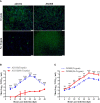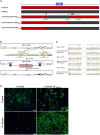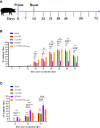Construction and immunogenicity of a trypsin-independent porcine epidemic diarrhea virus variant
- PMID: 37033982
- PMCID: PMC10080105
- DOI: 10.3389/fimmu.2023.1165606
Construction and immunogenicity of a trypsin-independent porcine epidemic diarrhea virus variant
Abstract
Porcine epidemic diarrhea virus (PEDV) is a re-emerging enteropathogenic coronavirus that causes high mortality in neonatal piglets. The addition of trypsin plays a crucial role in the propagation of PEDV, but also increases the complexity of vaccine production and increases its cost. Previous studies have suggested that the S2' site and Y976/977 of the PEDV spike (S) protein might be the determinants of PEDV trypsin independence. In this study, to achieve a recombinant trypsin-independent PEDV strain, we used trypsin-dependent genotype 2 (G2) PEDV variant AJ1102 to generate three recombinant PEDVs with mutations in S (S2' site R894G and/or Y976H). The three recombinant PEDVs were still trypsin dependent, suggesting that the S2' site R894 and Y976 of AJ1102 S are not key sites for PEDV trypsin dependence. Therefore, we used AJ1102 and the classical trypsin-independent genotype 1 (G1) PEDV strain JS2008 to generate a recombinant PEDV carrying a chimeric S protein, and successfully obtained trypsin-independent PEDV strain rAJ1102-S2'JS2008, in which the S2 (amino acids 894-1386) domain was replaced with the corresponding JS2008 sequence. Importantly, immunization with rAJ1102-S2'JS2008 induced neutralizing antibodies against both AJ1102 and JS2008. Collectively, these results suggest that rAJ1102-S2'JS2008 is a novel vaccine candidate with significant advantages, including no trypsin requirement for viral propagation to high titers and the potential provision of protection for pigs against G1 and G2 PEDV infections.
Keywords: chimeric virus; immunogenicity; neutralizing antibodies; porcine epidemic diarrhea virus (PEDV); trypsin-independent.
Copyright © 2023 Li, Zhang, Fang, Xiao, Fang and Fang.
Conflict of interest statement
The authors declare that the research was conducted in the absence of any commercial or financial relationships that could be construed as a potential conflict of interest.
Figures





Similar articles
-
Development of a safe and broad-spectrum attenuated PEDV vaccine candidate by S2 subunit replacement.J Virol. 2024 Nov 19;98(11):e0042924. doi: 10.1128/jvi.00429-24. Epub 2024 Oct 15. J Virol. 2024. PMID: 39404450 Free PMC article.
-
Epidemic strain YC2014 of porcine epidemic diarrhea virus could provide piglets against homologous challenge.Virol J. 2016 Apr 22;13:68. doi: 10.1186/s12985-016-0529-z. Virol J. 2016. PMID: 27103490 Free PMC article.
-
Rapid manipulation of the porcine epidemic diarrhea virus genome by CRISPR/Cas9 technology.J Virol Methods. 2020 Feb;276:113772. doi: 10.1016/j.jviromet.2019.113772. Epub 2019 Nov 8. J Virol Methods. 2020. PMID: 31712093 Free PMC article.
-
[Advances in reverse genetics to treat porcine epidemic diarrhea virus].Sheng Wu Gong Cheng Xue Bao. 2017 Feb 25;33(2):205-216. doi: 10.13345/j.cjb.160282. Sheng Wu Gong Cheng Xue Bao. 2017. PMID: 28956377 Review. Chinese.
-
Porcine epidemic diarrhea virus: Molecular mechanisms of attenuation and vaccines.Microb Pathog. 2020 Dec;149:104553. doi: 10.1016/j.micpath.2020.104553. Epub 2020 Oct 1. Microb Pathog. 2020. PMID: 33011361 Free PMC article. Review.
Cited by
-
Developing Next-Generation Live Attenuated Vaccines for Porcine Epidemic Diarrhea Using Reverse Genetic Techniques.Vaccines (Basel). 2024 May 19;12(5):557. doi: 10.3390/vaccines12050557. Vaccines (Basel). 2024. PMID: 38793808 Free PMC article. Review.
-
Reverse Genetics Systems for Emerging and Re-Emerging Swine Coronaviruses and Applications.Viruses. 2023 Sep 26;15(10):2003. doi: 10.3390/v15102003. Viruses. 2023. PMID: 37896780 Free PMC article. Review.
-
Epidemiological investigation, isolation, and pathogenicity of porcine epidemic diarrhea virus subtype G2c in Sichuan province.Arch Virol. 2025 May 16;170(6):129. doi: 10.1007/s00705-025-06308-3. Arch Virol. 2025. PMID: 40377695
-
Development of a safe and broad-spectrum attenuated PEDV vaccine candidate by S2 subunit replacement.J Virol. 2024 Nov 19;98(11):e0042924. doi: 10.1128/jvi.00429-24. Epub 2024 Oct 15. J Virol. 2024. PMID: 39404450 Free PMC article.
References
-
- Have P, Moving V, Svansson V, Uttenthal A, Bloch B. Coronavirus infection in mink (Mustela vison): Serological evidence of infection with a coronavirus related to transmissible gastroenteritis virus and porcine epidemic diarrhea virus. Vet Microbiol (1992) 31(1):1–10. doi: 10.1016/0378-1135(92)90135-g - DOI - PMC - PubMed
Publication types
MeSH terms
Substances
LinkOut - more resources
Full Text Sources

